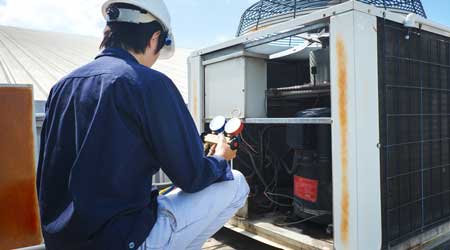 To build buy-in among facility executives, managers must show that HVAC technician training will benefit the organization.
To build buy-in among facility executives, managers must show that HVAC technician training will benefit the organization.Building Successful Training Programs for HVAC Technicians
Arming operators and technicians with the right skills can help managers deliver improved productivity and increased savings
For generations, maintenance and engineering managers have considered on-the-job training to be adequate for HVAC maintenance personnel. Technicians already doing the work would demonstrate and teach new hires everything they needed to know about facility systems and equipment. That strategy was fine during the time when systems were static or evolving slowly, but that is no longer the case.
Relying solely on on-the-job training does not cut it anymore. The demand for higher energy efficiency, greater system reliability, lower maintenance costs and longer equipment service lives has resulted in the development of more complex HVAC systems and components.
If managers hope to maximize their organizations’ investments in these advanced systems, they must make certain that the technicians who set up, operate, and maintain those systems have the proper skills to do so. And those skills are best acquired through proper training.
Identifying training needs
One of the worst things managers can do when it comes to HVAC training is to assume that they know what front-line technicians need. Operating deficiencies or a large number of equipment breakdowns might be a sign of poor operating practices that training can correct.
These problems also could be a sign that the department does not have enough maintenance personnel or that the equipment is getting older and needs to be replaced. But managers who assume they know what is wrong and that training is needed in order to fix it are not likely to provide the necessary improvement in operations.
A more effective approach is to start with a training-needs assessment. What do technicians need to know in order to perform the required operation and maintenance tasks successfully? What are their current skill levels?
If there is a gap between these two situations, what can managers do to close that gap? It would be a waste of time and money to train personnel on tasks that they are not required to perform or on tasks that they already know and are doing well.
For example, knowing how to re-tube a boiler is a great skill if the department actually re-tubes boilers in house. But most re-tubing is left to outside companies that specialize in boiler overhauls.
Technicians might need several types of training. New hires require initial training on the types of systems installed in the facility. Operators and maintenance personnel require training specific to those systems when new systems are installed. All employees require refresher training to improve their efficiency and productivity and to correct bad habits. Some technicians, particularly those who work after regular business hours, require cross-training so they can handle a range of potential problems without having to call in additional personnel.
Any successful training program focuses on those areas where technicians lack needed skills. In some cases, managers already have a feel for these areas. All of the following instances are signs that technicians’ current skill levels are not up to the task.
New systems might have been installed recently that are more sophisticated than anything else in the facility, and operators and maintenance personnel are struggling to understand the way they operate. Service calls might be required for equipment that should have been handled in-house. Shop managers might complain that maintenance just is not being performed properly.
Managers can further identify needed skills by talking to shop managers. Have them identify areas in which they believe additional training can help. Review the background and qualifications of operating and maintenance personnel. Understand the training they have completed, and compare it to the skill level they need to perform their expected tasks.
Managers also can talk directly to technicians. They know best what additional training can benefit them. Engaging personnel also can help get them to buy into training programs.
Related Topics:














